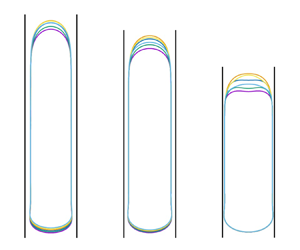Article contents
Volume oscillations slow down a rising Taylor bubble
Published online by Cambridge University Press: 04 January 2024
Abstract

A gas volume rising in a vertical tube is called a Taylor bubble when its equivalent spherical diameter is greater than the diameter of the tube. Continuity dictates that the rising velocity of such bullet-shaped bubbles must be such that the drainage flow in the liquid film separating the gas from the tube wall equals the rate at which space is vacated by the bubble tail on its rise. The numerical simulations presented here show that, if the volume of the bubble is made to execute small-amplitude oscillations, this drainage flow can be markedly decreased so that the bubble slows down so much as to very nearly stop. The mechanism is a subtle nonlinear interplay between the upward flow imposed by the bubble expansion and the inertia of the falling liquid. Two manners of excitation are considered. In the first one the liquid column above the bubble is forced to oscillate sinusoidally, e.g. by a piston. In the second one, an oscillating pressure is imposed on the top liquid surface. With the first arrangement the bubble slows down during its entire ascent by an amount depending on the oscillation frequency and amplitude. With the second one, for a given frequency, the bubble slows down only in the neighbourhood of a certain resonant depth at which the volume oscillations are maximized, but is little affected at deeper and shallower depths.
Information
- Type
- JFM Papers
- Information
- Copyright
- © The Author(s), 2024. Published by Cambridge University Press
References
- 4
- Cited by


